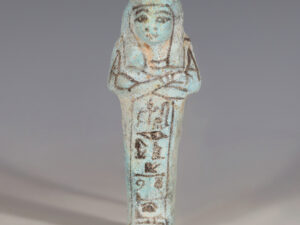Shabtis (or ushabtis) were figurines in mummified form, which were placed in Egyptian tombs to do any work required by the deceased in the afterlife. They could be inscribed with a special formula (Shabti formula), which would call them to life when recited. Sometimes shabtis were also inscribed with passages from the Book of the Dead, the intention of which was to secure safety for the deceased in the afterlife. Within the Third Intermediate Period the requisite number of shabtis was 401. The increase in number usually meant a decrease in size and quality. They also become known an ushabtis (answerers) during this time. If a formula was present it is usually only short, including the Osiris epithet, name and title of the deceased.
To discover more about Egyptian shabtis, please visit our relevant blog post: How Ancient Egyptian Shabtis and Funerary Statuettes Watched Over the Dead.
















